Quick note for future readers: the way you do an unpinch/pinch with three fingers is add the distances ab,bc,ac.
However if your graphics package just happens to have on hand "area of a triangle" - simply use that. ("It saves one whole line of code!")
Hope it helps.
All you need to do is track:
the distance between the three fingers!
Simply add up "every" permutation
(Well, there's three .. ab, ac and cb. Just add those; that's all there is to it!)
When that value, say, triples from the start value, that's an "outwards triple unpinch".
... amazingly it's that simple.
Angles are irrelevant.
Footnote if you want to be a smartass: this applies to any pinch/unpinch gesture, 2, 3 fingers, whatever:
track the derivative of the sum-distance (I mean to say, the velocity) rather than the distance. (Bizarrely this is often EASIER TO DO! because it is stateless! you need only look at the previous frame!!!!)
So in other words, the gesture is trigger when the expansion/contraction VELOCITY of the fingers reaches a certain value, rather than a multiple of the start value.
More interesting footnote!
However there is a subtle problem here: whenever you do anything like this (any platform) you have to be careful to measure "on the glass".
IF You are just doing distance (ie, my first solution above) of course everything cancels out and you can just say "if it doubles" (in pixels -- points -- whatever the hell). BUT if you are doing velocity as part of the calculation in any gesture, then somewhat surprisingly, you have to literally find the velocity in meters per second in the real world, which sounds weird at first! Of course you can't do this exactly (particularly with android) coz glass sizes vary somewhat, but you have to get close to it. Here is a long post discussing this problem http://answers.unity3d.com/questions/292333/how-to-calculate-swipe-speed-on-ios.html In practice you usually have to make do with "screen-widths-per-second" which is pretty good. (But this may be vastly different on phones, large tablets, and these days "surface" type things. on your whole iMac screen, 0.1 screenwidthspersecond may be fast, but on an iPhone that is nothing, not a gesture.)
Final footnote! I simply don't know if Apple use "distance multiple" or "glass velocity" in their gesture recognition, or also likely is some subtle mix. I've never read an article from them commenting on it.
Another footnote! -- if for whatever reason you do want to find the "center" of the triangle (I mean the center of the three fingers). This is a well-travelled problem for game programmers because, after all, all 3D mesh is triangles.
Fortunately it's trivial to find the center of three points, just add the three vectors and divide by three! (Confusingly this even works in higher dimensions!!)
You can see endless posts on this issue...
http://answers.unity3d.com/questions/445442/calculate-uv-at-center-of-triangle.html
http://answers.unity3d.com/questions/424950/mid-point-of-a-triangle.html
Conceivably, if you were incredibly anal, you would want the "barycenter" which is more like the center of mass, just google if you want that.


